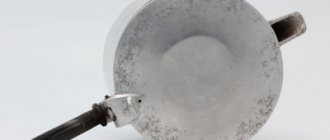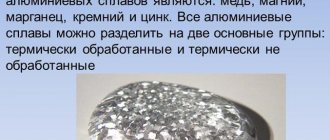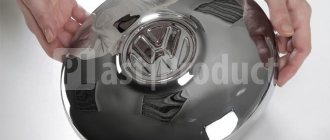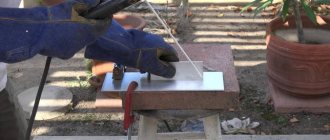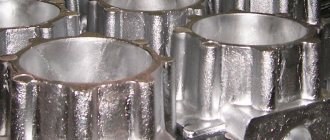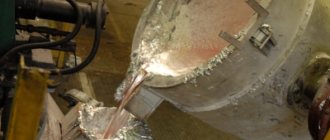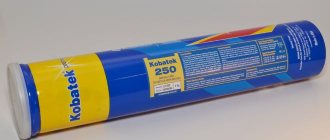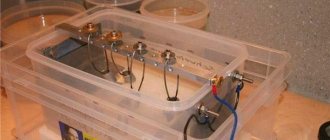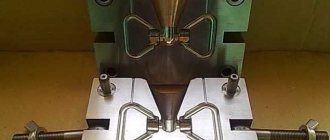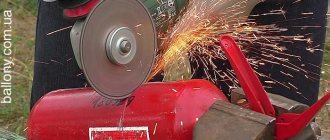Copper plating is the process of applying a layer of copper to the surface of various metals (aluminum, steel, nickel, brass). Copper plating gives metals a visual appeal that can be used in a variety of design projects. Also, the copper layer can improve the electrical conductivity of metal products, which significantly increases the possibility of further surface treatment.
Anyone who is at least a little familiar with the basics of chemical reactions can master the technology of copper plating aluminum at home.
History of the discovery of copper
Copper is the first metal that was conquered by man and played the greatest significance in the history of the development of civilization. This event took place several thousand years BC, and the exact date of the beginning of the use of this unique metal could not be established.
In ancient times, copper nuggets were used mainly to create weapons and household tools. Red-green metal nuggets were initially used in the same way as ordinary stones. Later, through experience, people noticed that processing this material with a hammer gives it special properties. This is how cold metal forging was born.
Even later, it was discovered that the metal melts and, after cooling, takes on different shapes and properties. This stage was the initial stage in the development of hot metal forming.
Characteristics and composition of copper
Copper is a heavy metal with a rose-red color, which is highly soft and melts at a temperature of more than 1080℃. The electrical conductivity of copper coating is 1.7 times higher than that of aluminum. Copper also has high thermal conductivity.
Many specific properties of the metal are due to the presence of various impurities in its composition. So, according to the oxygen that copper contains, the metal is divided as follows:
- copper without oxygen contains impurities of less than 0.001%;
- refined copper contains oxygen 0.001–0.01%;
- pure copper contains oxygen about 0.03–0.05%;
- General purpose copper contains 0.05–0.08% oxygen.
The presence of lead or bismuth in copper reduces the plasticity properties of the material. Slightly soluble impurities (sulfur, lead, bismuth) increase the fragility of the metal.
During the electrolysis process, in addition to oxygen, hydrogen can enter the composition of copper alloys.
Physical properties
The main quality of copper is low resistivity and, as a result, high electrical conductivity. An increase in impurities of various metals in a copper alloy significantly reduces the electrical conductivity of the material.
The high thermal conductivity of pure copper is significantly reduced when various alloying substances are added to its composition.
Also often used in industry are copper products that are highly resistant to corrosion in various environments, except organic acids, ammonia and ammonium salts. An increase in the amount of impurities in the copper composition leads to a significant decrease in the corrosion resistance of the alloys.
The purpose of copper plating of metals and their scope of application
Copper has a set of properties that determine the conditions for its use in copper plating of metals and non-metallic materials. It is plastic, easy to polish, and the galvanic layer after copper plating has virtually no pores. For this reason, copper coatings are very often used as a sublayer for chrome and nickel plating of products that are operated under conditions of constant compression and tension. The ductility of copper is an ideal condition for its use in electroforming. Thick-layer copper plating of artistic products and complex models allows you to create their absolutely exact copies that do not crack or deform when removed from the original.
Read also: What is the difference between a circular saw and a circular saw?
Copper has the best electrical conductivity among base metals and is easily soldered. Therefore, copper plating of steel products is widely used in radio engineering and electrical engineering in the manufacture of conductors, contacts, antenna parts and waveguides. When high-frequency signals are used, the copper coating experiences a high current density (skin effect), which reduces the overall resistance of the conductor.
Another area of use of copper plating is the creation of thin conductors on the surfaces of plastic products, as well as the coating of plastic with conductive layers.
Practical application of copper plating of metals
The procedure for copper plating of aluminum and other metals has a fairly wide practical application not only in domestic use, but also on an industrial scale. On many metals, a copper coating can be applied both as a main independent layer and as a sublayer for effective adhesion of the next main coating to the base metal of the product.
In most cases, copper plating of aluminum in home workshops is carried out for the following purposes:
- decoration of jewelry;
- protection of metal parts from corrosion and cementation;
- elimination of damage and surface defects of products with complex shapes and reliefs;
- making copies of products made from various materials;
- creating contact pads for soldering aluminum without the use of an acid composition;
- preliminary preparation of the surface of parts before chrome, silver, and nickel plating.
What is the copper plating process?
Copper plating is the process of applying a thin layer of copper to the surface of an object. It is performed by the galvanic method, that is, by transferring copper ions from a positively charged source to a negatively charged surface to be treated. Most often, the process of electroplating copper is a preparatory step before plating with nickel and chromium, but often copper plating of metal becomes an independent type of finishing. Electroplating, which requires the creation of a copper coating, is widely used.
Types of copper plating of a metal surface
The procedure for copper plating aluminum at home is not difficult to do yourself. It is not necessary to use special equipment and active chemicals. High-quality coating is ensured through strict adherence to aluminum copper plating technology and knowledge of the ongoing processes.
There are two main types of copper plating of metal surfaces:
- With the immersion of a workpiece in an electrolyte, in which the product is partially or completely immersed in a bath of a chemical reagent. The use of this method is justified when it is necessary to apply a layer of copper evenly over the entire product.
- Copper plating without immersing the part in a chemical solution. This method is more difficult to implement. Its use is very effective if you need to copper plating a certain area of the product.
In both of these cases, the activation of the substance for chemical copper plating of aluminum is carried out electrically, which requires the use of a constant voltage source.
Electroplating at home: equipment and materials
To perform copper coating yourself, you need to purchase the necessary equipment and materials for the process.
First of all, you need to prepare a source of electric current. Various home craftsmen advise using current strength, which varies over a wide range. Work must be carried out on direct current.
As a current source, you can take a KBS-L battery with a voltage of 4.5 volts or a new Krona brand battery with an operating voltage of 9 volts. You can also use a low-power rectifier instead, which produces a voltage of no more than 12 volts, or a car battery.
It is mandatory to use a rheostat to regulate the voltage and smooth exit from the process.
For the electrolyte solution, a neutral container should be prepared, for example, made of glass, as well as wide plastic dishes that are sufficiently sized to accommodate the part. Containers must withstand temperatures of at least 80°C.
You will also need anodes to ensure coverage of the entire surface of the part. They are designed to supply current to the electrolyte solution and distribute it over the entire area of the part.
To carry out electroplating at home, you will also need chemicals to prepare the solution:
- copper sulfate,
- hydrochloric or other acid,
- distilled water.
Having prepared everything you need, you can start working.
Video:
Immersion Copper Plating Equipment
To perform high-quality technological operations of aluminum copper plating, it is necessary to prepare simple equipment. The corresponding tools and materials can either be purchased at a retail chain or made independently.
To complete the work you will need the following materials and equipment:
- A 6-8 volt DC power supply with a continuously variable current control device and an ammeter. If there is no adjustment, then it is advisable to include a rheostat and an ammeter in the circuit. They will be needed to control the process. If there is no stationary power supply, then you can use a Krona type battery.
- A special bath made of material that is not subject to electrolytic effects (glass, plastic). The dimensions of the container are selected in accordance with the dimensions of the workpiece.
- Copper electrodes, which serve to supply electric current to the electrolyte during copper plating of aluminum, and also replenish the loss of metal during the reaction.
- Electrolyte, the composition of which depends on the material of the original workpiece.
Copper plating of parts in a solution with electrolyte
For metal parts, you can perform copper plating at home. Let's consider copper plating, with the part being lowered into a solution with an electrolyte. To do this you need to have:
- small copper plates,
- several meters of conductive wire;
- current source, with voltage up to 6 V;
- It is also recommended to use a rheostat to regulate the current and an ammeter.
- An ordinary electrolyte is used as a liquid that dissolves copper well. You can buy it or prepare it at home. This will require 3 ml
of sulfuric acid
for every 100 ml of distilled water
. The required solution can be obtained by adding up to 20 g to the resulting electrolyte. copper sulfate. - Before starting the copper plating process, the part must be cleaned with sandpaper to remove the oxide film from the surface.
- Then, the part is degreased with a hot soda solution and washed with clean water.
- The prepared electrolyte solution is poured into a glass container of the required volume.
- Then, two copper plates are lowered there, on current-carrying wires. Between two copper plates, a part intended for copper plating at home is suspended on a similar wire. It is necessary to ensure that the copper plates and the part are completely filled with the electrolyte solution.
- At the next stage, the ends of the wires from the copper plates are connected to the positive terminal, and the workpiece to the negative terminal of the current source. A rheostat and an ammeter must be connected in series to the created electrical circuit. After turning on the current in the circuit, it is set by a rheostat within 15 mA per 1 cm? surface area of the part.
- After keeping the workpiece in the solution for 15-20 minutes, you need to turn off the power supply and remove the product from the solution. During this short period of time, the surface of the part will be covered with a thin layer of copper. The thickness of the coating will depend on the duration of the copper plating process. Thus, it is possible to achieve copper plating of the surface of any product with a layer of 300 microns or more.
Preparation of solution for copper plating
It is difficult to find a ready-made solution for copper plating of aluminum in the retail chain. Typically, manufacturers allow the sale of the finished substance upon presentation of the appropriate documents. Therefore, most people make their own solution for copper plating of aluminum at home from copper sulfate.
For these purposes you will need:
- copper sulfate;
- distilled water;
- hydrochloric acid.
The solution can only be prepared if the recipe is followed correctly. To do this, you need to dissolve copper sulfate (20 g) in 1 liter of water. Then add 2-3 ml of acid in a thin stream. The composition is thoroughly mixed until all crystals are completely dissolved.
The finished electrolyte for copper plating of aluminum with copper sulfate should be odorless and have a bright blue color.
Use of copper plating
Copper plating of various workpieces has recently often been carried out at home. In most cases, technology is used to achieve the following goals:
- Decorating metal or plastic. Copper plating of metal at home is often carried out in order to obtain antique-looking products that are very popular. A special aging procedure allows you to create the effect of long-term use of the product. In addition, copper after application resembles gold. That is why a small layer can be applied to obtain a figurine or souvenir.
- Electrotype. Copper plating of steel in a similar way can also be carried out at home. The essence of the technology is to create a wax or plastic base, which is covered with a layer of the alloy in question. Electroforming is often used to produce jewelry or souvenirs, matrices and waveguides. The use of special materials can significantly improve the quality of the coating.
- Obtaining parts used to create various mechanisms. Copper plating of cast iron or other metal is carried out at production sites using various technologies. Coating the workpiece with copper can significantly improve the electrical properties. In a similar way, you can obtain terminals or other similar elements that will be operated under voltage. Products made from pure copper are very expensive. That is why the technology in question is often used.
Copper plating of steel
Copper plating of plastic at home is extremely rare, since such material cannot withstand high temperatures. In addition, the plasticity of the base leads to the appearance of structural cracks.
Copper plating technology by immersion method
Copper plating of aluminum metal by completely immersing the workpiece in an electrolyte is carried out using the following technology:
- The surface of the workpiece is cleaned with sandpaper or a brush, then degreased in a hot soda solution and washed under running water.
- Two electrodes are suspended into the prepared container and connected to the positive terminal of the power source.
- A workpiece is placed between the electrodes and connected to the negative terminal of the power supply.
- The prepared electrolyte is poured into the working container. The solution level should be above the top edge of the electrodes.
- Using the adjustment device, the operating current value is set. The parameter value is calculated at the rate of 10-15 mA per 1 cm2 of the area of the workpiece being processed.
- After 20 minutes, the power is turned off and the workpiece is removed from the bath.
- The remaining electrolyte is washed off with water and the part is dried.
The process time is indicated approximately; it can be controlled visually by the color of the coating and the uniformity of its distribution. The longer the power is connected, the thicker the aluminum copper plating layer will be.
Types of copper plating
The procedure in question can be performed even by beginners in the field of metallurgy. To obtain a high-quality surface, you need to know all the features of the process. Copper plating of lead and other metals at home can be carried out using two different technologies:
- Immersed in electrolyte. This technology involves dipping the workpiece into a prepared solution, after which voltage is applied. It is often used when the workpiece is small in size, since a smaller amount of special electrolyte is required. To immerse the workpiece, a bath or other container is required that does not react to the effects of the solution used.
- Without immersion in a pre-prepared container. It is difficult to implement, but also allows you to achieve high quality copper surface film.
In both cases, a supply of electricity is provided, due to which the substance is activated.
The most suitable processing method is selected depending on the result to be achieved. Let's take an example:
- Obtaining a protective and decorative layer. In this case, chromium is often mixed with nickel and copper. Due to this combination of alloys, a reliable surface can be obtained.
- To protect the surface during cementing. Applying a thin layer of copper helps protect the workpiece from cementation. The surface that will be subsequently processed by cutting is covered with the solution.
- Restoration and repair of parts. When restoring chrome parts of cars and motorcycles, the technology in question can be used. When applying a layer of no more than 250 microns, surface defects in the metal can be hidden.
Both processing technologies have their own specific characteristics that must be taken into account.
Copper plating in solution with electrolyte
Electroplating with copper at home with immersion is carried out extremely often. This technology allows you to obtain a uniform coating. The features of this processing method include the following points:
- To remove the oxide film before copper plating, the workpiece is treated with sandpaper. After this, the product is washed and degreased with a hot soda mixture. If you do not pay attention to the preparatory stage, the process being carried out will not allow you to obtain a product that is resistant to mechanical stress. Metal that is susceptible to corrosion must be well cleaned, since even small chips can make the surface uneven.
- Two plates of the same alloy are lowered into a jar or other container on copper wires. They act as an anode. The container used must be made of glass.
- The workpiece is suspended between two anodes, which is connected to the minus, and the plates to the plus. A battery producing a voltage of 6V can be used as a power source.
- Galvanic copper plating involves the use of a specific solution. It is the connecting element between the part and the anodes. A solution for galvanic copper plating can be prepared by taking 20 grams of copper sulfate and 3 milliliters of sulfuric acid. To dilute and mix these ingredients, you can use 100 milliliters of distilled water. When working with the resulting solution, you must be extremely careful, since burns may occur if the substance comes into contact with exposed skin.
- Copper plating of aluminum with copper sulfate at home can only be carried out if the electrodes are completely covered with the solution. If they are kept dry, they may heat up and melt. During prolonged processing, the substance may heat up and its volume will decrease.
Galvanic copper plating
When using the technology in question, the current is set at 15 mA per square centimeter. It usually takes at least 20 minutes to cover the entire surface with a special alloy. As the period increases, the coating becomes thicker.
Copper plating without immersion in solution
A similar method is used to coat steel, zinc or aluminum. Coating a product with copper at home in this case is carried out with a wire, from which the insulation is first removed to obtain a kind of brush. The opposite end of the wire is connected to the positive energy source. Chemical copper plating at home also involves the use of a special solution, which increases the efficiency of the process.
Among the features of creating the required solution, the following points can be noted:
- A solution of copper sulfate is used. It can be purchased in specialized stores. In addition, a special electrolyte is made by mixing various chemical elements.
- The composition is slightly acidified. Due to this, the efficiency of the procedure is significantly increased.
The substance is applied to the surface, after which the metal surface is prepared. It is cleaned of contaminants and then degreased. After this, the plate prepared in advance is placed in the bath and a minus voltage from the current source is supplied to it.
Copper plating of aluminum
This process requires that there is always a layer of electrolyte between the assembled wires and the plate. This ensures a high degree of conductivity. It only takes a few seconds to coat a small product.
After coating, the product is air dried. Various pollutants must not be allowed to enter. The next step is to rub the copper layer with a woolen rag or other cloth. In most cases, the technology in question is used when the product is large and cannot be immersed in a bathtub.
Devices for copper plating without immersion
Work on copper plating of metal workpieces without immersion in the electrolyte is carried out on large products that cannot be completely immersed in the bath. This method is also more effective when processing individual parts of the product.
To perform technological operations for copper plating without immersion in the electrolyte, you will need the following devices:
- The brush for applying the chemical composition is made of stranded copper wire. For this purpose, you need to strip the insulation at one end of the wire, then slightly separate the individual conductors. To make it convenient to hold the brush, it is better to tie it to a wooden stick or pencil.
- It is better to place the workpiece to perform the work in any container without high sides. It is convenient to use an ordinary porcelain or glass plate. Additionally, you will need a container for electrolyte, into which the brush will be constantly dipped. You can use a glass for this purpose.
- The power source does not differ in parameters from the power supply used in immersion technology.
Copper plating of the part, without immersion in the solution
The second method of copper plating metal products at home involves performing this process without immersing the workpiece in an electrolyte solution.
This option is suitable for coating zinc and aluminum products.
- For this method of copper plating, you will need a stranded copper wire, from both ends of which it is necessary to remove the insulation. On one side, the soft wire needs to be ruffled. This produces a product in the form of a brush. To make it more convenient to work in the future, you need to tie a solid object in the form of a handle to this end of the wire. The second cleaned end of the wire must be connected to the positive terminal of the electric current source. The voltage should not exceed 6 V.
- Using the previously described method, you need to prepare an electrolyte mixed with copper sulfate. In this method of copper plating of parts, the solution can be poured into any container. It is recommended to choose a wide container so that it is convenient to dip the copper wire brush. Next, you need to place a small metal piece in this dish, with low edges. First you need to clean it, boil it in liquid with washing powder, and rinse it. This part must be connected using a wire to the negative terminal of the current source, with a voltage of 6 V.
- The copper plating process occurs as follows. The frayed end of the copper wire must be periodically dipped in an electrolyte solution with copper sulfate and passed along the part without touching its surface with a “brush”. But it is necessary to ensure that there is a small layer of solution between the end of the brush and the part (the cathode and anode must always be moistened with electrolyte). During the copper plating process, the negatively charged part attracts copper ions and its surface is covered with a small red layer. After applying the coating, the product must be dried and rubbed until shiny.
This type of copper plating, without immersing the product in an electrolyte, is often used to process large parts. They do not fit into the selected container with electrolyte, and the surface is treated with a brush in small areas.
Video guide to copper plating parts at home
Source: boldproject.ru
Copper layer application without immersion
The technology for performing work on copper plating of aluminum without immersing the workpiece in the electrolyte is as follows:
- The brush, prepared in advance, is connected to the positive terminal of the power supply.
- An electrolyte solution, which is similar in formulation to the composition used in the case of immersing the part, is poured into a container to wet the brush.
- The workpiece, previously cleaned and degreased, is placed in an empty container. Using a connector, the part is connected to the minus of the power source.
- The brush is dipped into the electrolyte and moved over the place where it is necessary to apply a copper layer. It is very important that the brush does not touch the surface of the part.
- After applying a layer of copper, the workpiece is washed under running water and dried.
While working, you need to ensure that there is always a layer of electrolyte between the workpiece and the brush. To do this, the brush must be constantly dipped into a container with the solution.
Galvanic coating of aluminum and its alloys
Home » Blog » Electroplating of aluminum and its alloys The purpose of electroplating of aluminum and its alloys is to combine a number of valuable properties of the base metal (alloy) and the coating. For protective and decorative finishing of products made of aluminum and its alloys, they resort to applying combined coatings of copper - nickel - chrome or nickel - chrome. In order to protect against mechanical wear, relatively thick chromium coatings are applied, and to impart anti-friction properties, coatings from a lead-tin or copper-tin alloy are applied. To facilitate and speed up the soldering process of aluminum products, tin, lead-tin or silver coatings are applied. The latter are also used to reduce contact resistance at contact points. Brass coatings provide strong adhesion between aluminum and rubber during hot pressing. To protect against seizing, threaded aluminum parts are galvanized. Cadmium plating is applied to units in which aluminum parts are combined with steel, copper and other parts, in contact with which corrosion increases.
Various parts of electronic devices are subjected to silvering, gilding, coating with platinum metals and their alloys.
Specific difficulties in applying galvanic coatings to products made of aluminum and its alloys are associated with the presence of a natural oxide film on their surface, which prevents strong adhesion between the base and the coatings. In addition, the strongly electronegative potential of aluminum, freed from the oxide film, leads to the displacement of ions of the coated metal before the passage of electric current through the electrolyte solution, which also disrupts the adhesion between the coating and the base. Overcoming these difficulties is achieved by special methods of preparing the surface of coated products. The most common methods for preparing the surface of aluminum products before applying galvanic coatings are the following: 1) zincate, 2) anodization in phosphoric acid, 3) preliminary electrolytic deposition of the thinnest zinc or brass coatings.
The zincate method of preparing the surface of aluminum products boils down to their short-term immersion (for 30-60 s) in a solution of sodium zincate. The oxide film dissolves and the products are covered with a thin film of zinc (0.1-0.15 microns), which prevents the surface from re-oxidation. In this case, the following reactions occur. At the anodic sections: Al + ZON- → Al(OH)3 + Ze, Al(OH)3 → AlO2 + H2O + H+ At the cathodic sections: Zn(OH)4 → Zn2+ + 40H-, Zn2+ + 2e → Zn, 2H+ + 2e → 2H → H2.
Due to the high overvoltage of hydrogen on zinc, the latter reaction is difficult and the formation of a zinc film on the surface of aluminum products is not accompanied by a noticeable release of hydrogen.
The thinner and denser the zinc film, the greater the adhesion strength of the aluminum base to the galvanic coating. The formation of a dense film is facilitated by the introduction into the zincate solution, in addition to the main components (zinc oxide and caustic soda), ferric chloride and Rochelle salt, as well as sodium nitrate. Below are the recommended compositions of zincate solutions (g/l) and their modes:
Double dip galvanizing often provides better adhesion between the aluminum base and the galvanized coating. After 10-15 seconds of exposure in the zincate solution, the products are washed in water and transferred to a solution of nitric acid diluted with water in a ratio of 1: 1 to remove the zinc coating. After thorough washing in water, the products are again immersed in the zincate solution. Below is a diagram of the process of applying galvanic coatings to aluminum alloys when preparing their surface using the zincate method:
To prepare the surface of aluminum alloys alloyed with magnesium for electroplating, it is recommended to immerse them in a solution of zinc sulfate in the presence of hydrofluoric acid or in a solution of zinc fluoroborate. The compositions of these solutions (g/l) and modes are given below:
1) ZnSO4·7H2O …………….720 HF (48%), % (volume). . 3.5 Temperature, °C…………..50 Duration, s. . . . 20—60 2) Zn(BF4)2………………75 pH…………………..3.0 Duration, s……….30
Anodizing in phosphoric acid is used in the USA for aluminum alloys alloyed with copper and manganese before galvanic copper plating. The oxide film formed during anodization in phosphoric acid is thinner and more porous than when anodizing in sulfuric acid, but the part of the film that faces the aluminum alloy (the so-called barrier layer) is thicker than in sulfuric acid. Therefore, anodization in phosphoric acid is carried out at increased voltage (30-60 V). The concentration of phosphoric acid ranges from 250-500 g/l, temperature 25-30 ° C, current density 1.0-2.0 A/dm2, anodizing duration about 10 minutes, oxide film thickness about 3 microns. When anodizing in phosphoric acid, the more difficult the purer the aluminum, the more difficult it is: for unalloyed aluminum, it is difficult to ensure good adhesion to the galvanic coating. It is recommended to deposit the first layers of copper in a pyrophosphate electrolyte at pH values = 7÷8 (Fig. 122).
Rice. 122. Micrograph of an aluminum sample subjected to anodization in phosphoric acid and subsequent copper plating and nickel plating
The metal on aluminum oxidized in phosphoric acid begins to precipitate in the pores in the form of fine fibers, which then grow together, throwing bridges through the film. The fact that the oxide film itself is firmly adhered to the base also ensures strong adhesion to the galvanic coating. In England and the USA, the so-called Vogt process is widely used, which consists of preliminary application of the finest zinc and brass coatings to aluminum products. Below are the compositions of electrolytes (g/l) and their modes for galvanizing baths (I) and brass plating (II):
According to this scheme, after washing, fat-free products are etched for 5 s in 5% HF and clarified in HNO3 (1: 1). After thorough washing, the products are subjected to galvanic coating with minimal breaks between operations according to the following scheme: galvanizing - rinsing in running water - brass plating - rinsing - neutralization in a weak solution of tartaric acid - nickel plating (in an electrolyte without chlorides) - rinsing in cold and hot water - dismantling with pendants - heating at 200-250° C for 30 minutes.
When applying galvanic coatings to aluminum products prepared using one of the methods listed above, special precautions must be taken. The fact is that the zinc film obtained by immersion in a zincate solution, as well as zinc and brass films obtained by electrodeposition, are extremely thin and it is necessary to apply the first layer of metal on them from such an electrolyte and in such a mode that they are not damage. In foreign literature, it is recommended to apply the first layer of copper from a cyanide electrolyte with a small content of free cyanide to products prepared using the zincate method. The composition of such an electrolyte is given below (g/l):
CuCN….. 42 Na2CO3…. 30.0 NaCNtotal ... 49 KNaC4H4O6 4H2O . 60.0 NaCNfree. . . Up to 3.8 Electrolyte temperature within 38-43° C, pH = 10.2÷10.5.
The products are suspended in a bath under current and the current density is maintained at 2.5 A/dm2 for 2 minutes, after which it is reduced to 1.25 A/dm2 for at least 3-5 minutes. In the future, using this mode, you can increase the copper layer to the required thickness, or after washing in water, transfer the products to a copper acid bath. During protective and decorative chrome plating, products after copper plating are coated with nickel and chromium using generally accepted technology - either with intermediate polishing with all auxiliary operations, or without them, if the coating is carried out in baths with brightening agents. Instead of copper plating in a cyanide electrolyte, when performing protective and decorative chrome plating, you can start with brass plating in an electrolyte of the following composition (g/l):
CuCN…. 26 NaCN…. 45 Zn(CN)2 … 11 Na2CO3 … 7.5
The temperature is maintained within 27-30° C, the current density is about 1 A/dm2, the anodes are brass containing 70-75% Cu and 25-30% Zn. Protective and decorative chrome plating of products prepared using the zincate method according to the Ni-Cr or Ni-Cu-Ni-Cr scheme can be carried out without applying the first layer of copper or brass in cyanide electrolytes. For this purpose, nickel can be applied to the zinc film from a conventional electrolyte, or from an electrolyte composition more suitable for this purpose (g/l): NiSO4 7H2O…….100 Na2SO4 10H2O…………..15 H3BO3………… ……..10 Sodium citrate … 15
Electrolyte temperature 40-45° C; current density 1.5-2 A/dm2; pH~5.6. Strong adhesion of the nickel coating to the aluminum base is ensured only as a result of 30 minutes of heating at a temperature of 200-250 ° C. To prevent surface oxidation, it is recommended that heating be carried out in an oven with an inert atmosphere in technical castor oil or in a vacuum. If such heating is difficult, then before applying other electroplating coatings to the nickel, a thin layer of oxides can be removed either by polishing or by etching in a mixture of sulfuric and nitric acids. For light operating conditions, you can limit yourself to a nickel layer 10 microns thick, followed by chrome plating to a thickness of up to 1 microns; for harsh conditions, a total thickness of Ni-Cu-Ni coating of 50 microns with a thin layer of chromium is recommended.
Wear-resistant chromium plating is often applied to cylinder engines (for example, motorcycles) made of silicon aluminum alloys. After degreasing in an alkaline solution and washing, 1-2 minutes of etching follows at a temperature not exceeding 15°C in a mixture of HF:HNO3 in a ratio of 1:5. Chromium plating is carried out in a conventional electrolyte at a temperature of 60±2°C according to the following mode: first 5 minutes at a current density of 35-45 A/dm2, the second 5 minutes 45-65 A/dm2, the rest of the time 65-80 A/dm2. Galvanic tinning or coating with a lead-tin alloy (to facilitate and speed up the soldering process) of products prepared using the zincate method is carried out in conventional electrolytes after nickel plating and 30-minute heating or after copper plating in a cyanide electrolyte. Aluminum products are relatively rarely subjected to galvanizing the best results are obtained after zincate treatment and electrolytic galvanizing in alkali cyanide electrolytes.
Cadmium plating is used to protect against contact corrosion of assemblies in which aluminum parts are mated with parts made of other metals. Strong adhesion of cadmium coatings to the aluminum base can be ensured after preliminary one-minute cathodic polarization at a current density of 2.5 A/dm2 in an electrolyte diluted in cadmium content and subsequent cadmium plating in the working electrolyte at a current density of 1.5-3 A/dm2 for a period of time , necessary for deposition of a cadmium layer of a given thickness. The following are the compositions (g/l) of the recommended electrolytes for pre-coating (I) and working electrolyte (II): I II Cd……… 7.5 27 NaCN……. 60.0 100
In addition to the main components, a brightening agent is introduced into the working electrolyte. It is also possible to cadmium-plate aluminum over a copper or zinc sublayer after zincate treatment.
Silvering of aluminum is carried out to increase electrical conductivity and, in particular, to reduce contact resistance at contact points. After zincate treatment, the products are silvered sequentially in three baths with a gradually increasing concentration of silver and a decreasing concentration of free cyanide. In the first two baths, the products are kept for 10-15 s at a current density of 1.5-2 A/dm2. In these baths, the current output of the metal is small and intense hydrogen evolution is observed. In the third bath, a current density of 0.5 A/dm2 is maintained and the process continues until a silver layer of a given thickness is obtained. The following are the silver electrolyte compositions of these three baths (g/l):
I II III Ag CN 1 5 30 K CN 90 68 60
For light operating conditions, you can limit the thickness of the silver layer to 12.5 microns, for medium operating conditions - 25 microns, and for harsh conditions - 50 microns. Coating with other precious metals . Various parts of electronic equipment, automation and telemechanics, depending on operating conditions, are gold-plated or coated with platinum group metals. Gilding is carried out after zincate treatment and application of a copper sublayer of cyanide electrolyte or a nickel sublayer, followed by 30 minutes of heating. Thick gold coatings (up to 25 microns) can be obtained from cyanide electrolyte (8 g/l Au, 20 g/l KCNfree, 20 g/l K2HPO4 and 20 g/l K2CO3) at a temperature of 65-70 °C and a current density of 0 .3—0.5 A/dm2. Recently, so-called acidic cyanide electrolytes for gilding of approximate composition (g/l) and mode have been successfully used: Gold (in the form of potassium dicyanoaurate) ………………….10 Potassium citrate…………80 Citric acid ………….20 pH………….5.5-6 Temperature, °C…………….70 Current density, A/dm2…………0.5 To increase the hardness and wear resistance of gold coatings, it is recommended to introduce 15 mg/l into the electrolyte antimony in the form of potassium antimonate. The coating contains up to 1% Sb, the microhardness reaches 180 kgf/mm2.
Of the platinum group metals, rhodium plating is most widely used in new industries. For aluminum products, copper and nickel sublayers can be used equally after zincate preparation. Thin rhodium coatings of the order of 1-2 microns can be obtained from a sulfate electrolyte containing 1-2 g/l Rh in the form of sulfate salt and 20-25 ml/l concentrated sulfuric acid. To obtain thicker rhodium coatings, the rhodium content in the electrolyte must be increased to 10-15 g/l and 1 g/l selenic acid must be introduced, which reduces the internal stresses in the coating and makes it possible to increase its thickness to 25-50 microns. The process is carried out with insoluble (platinum) anodes, at a temperature of 45-50 ° C and a current density of 1-2 A/dm2. Electrodeposited rhodium has a hardness of about 800 kgf/mm2, great corrosion resistance and is second only to silver in terms of light reflection. Unlike silver, rhodium does not tarnish under the influence of hydrogen sulfide, and, when applied even in thin layers (0.1-0.2 microns) to silver, protects it from tarnishing.
All galvanic coatings, with the exception of zinc, are cathodic towards aluminum, i.e. they protect it from corrosion only if there are no pores in the coating. Non-porous coatings are usually obtained in layers of sufficient thickness and subject to the correct process conditions. If aluminum parts are operated under lubricated conditions, in a dry atmosphere or vacuum, then pores in the coatings can be neglected.
In the USSR and abroad, industrial use has been made of tinning aluminum pistons (for lapping purposes) by immersing them in a solution of sodium or potassium stannate. Pistons are degreased using one of the methods adopted for aluminum alloys. After washing in water, they are immersed for 20 s in nitric acid diluted in a ratio (1:1), washed again in water and immersed for 3-4 minutes in a solution containing 45-70 g/l Na2Sn(OH)6 or K2Sn( OH)6 at a temperature of 50-75° C. The pistons removed from the stannate solution are washed in cold and hot water. The thickness of the tin coating in this mode is approximately 5 microns, the color of the coating is white, matte. Potassium stannate is somewhat more expensive than sodium stannate, but its solutions are more stable and less susceptible to hydrolysis. Tin coatings obtained by immersion in a stannate solution are not sufficiently bonded to the substrate for products with such coatings to be soldered. They also cannot serve as an intermediate layer for subsequent electrolytic deposition of tin. Soldering requires zincate surface treatment (or another of the above) followed by the application of an underlayer of copper or nickel.
Safety precautions when performing work
All work with chemical reagents and an electrical source must be carried out in compliance with the necessary safety precautions.
Copper plating of aluminum in a residential area is strictly prohibited. For these purposes, it is better to use a utility room, garage or workshop. Electrical equipment must be grounded.
To protect human health, the following recommendations must be followed:
- to protect the respiratory system you need to use a respirator;
- To prevent chemicals from getting into your eyes, you must wear safety glasses;
- All work should be carried out in special clothing (rubber gloves, oilcloth apron, special shoes).
The process of coating aluminum products with a layer of copper is not particularly difficult even for a person who is little familiar with the flow of chemical reactions. Buying or manufacturing the appropriate equipment will also not cause any special problems. But many products that seem to have lost their attractive appearance will acquire a second life.
Electrotype
Copper plating can be done on more than just metal objects. Electroplating is widespread, when copper plating is performed on various dried plants, insects and other non-metallic objects.
The coating technology differs little from the usual one, only at the beginning of the process it is necessary to apply an electrically conductive varnish to the surface. After the varnish coating has dried, the usual steps are to apply a layer of copper. The resulting products have high decorative or artistic qualities and are highly appreciated by viewers.
